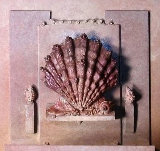-

-
Luis Ortiz Monasterio
MexicoArt Brokerage: Luis Ortiz Monasterio Mexican Artist: b. 1906-1990. Luis Ortiz Monasterio (August 23, 1906 in Mexico City – February 16, 1990 in Mexico City) was a Mexican sculptor noted for his monumental works such as the Monumento a la Madre and the Nezahualcoyotl Foundation in Chapultepec Park. His work was recognized in 1967 with the Premio Nacional de Artes and was a founding member of the Academia de Artes. With a career that spanned over sixty years, Ortiz Monasterio is one of the main figures of Mexican sculpture in the 20th century. He is one of few to be active during the dominance of the Mexican muralism movement and one of fewer of the century to be remembered. The artist began his career in 1927 as a drawing teacher at the Escuela de Maestros Contructores of the Secretaría de Educación Pública, after returned from studies in the United States. He went on to be a long-time teacher of the Escuela Nacional de Artes Plásticas ENAP from 1939 to 1962 and taught at La Esmeralda as well. In 1928, Ortiz Monasterio returned to Los Angeles to sculpt full-time, having his first individual exhibition at the Book Shop Gallery and a later one at Gump's Art Gallery in San Francisco. In the 1930s he created a number of sculptures which made him known for their originality of form and texture:El soldado herido (1932), La Victoria (1935), El nacimiento de Apolo (1936) and La Venus (1937). He had two shows at the Galería de Arte Mexicano an at UNAM in 1935 and 1936. In 1946 he participated in the International Sculpture Exhibition at the Philadelphia Art Museum, which acquired a work called Cabeza de mujer (1945). Another piece was acquired by the Museum of Modern Art in New York. Ortiz Monasterio is of the generation of Mexican sculptors which includes Oliverio Martínez, Francisco Marín, Juan Cruz Reyes, Federico Cantú,Federico Canessi and Carlos Bracho, which adopted elements of Art Deco and Cubism, using figures from the working class and indigenous populations. His artistic style is characterized by the use of classical and geometric elements, along with pre Hispanic influence. There is also influence from an artist named Ivan Mestrock, a Yugoslav artist whose works he saw in art magazines from Europe. In his works, he applied concepts from numerology and Pythagorism along with metaphysical concepts from the Aztec and Mayan cultures.nnHis work can be divided into two types. The first are monumental public works with historical themes, such as the Nezahualcoyotl Fountain in Chapultepec (1956) and the Plaza Cívica de la Unidad Indepedencia (1962). His smaller works often consists of sensual human forms as well as those with a mechanical feel.
Read More + - Create Listing 0 Artworks for sale 0 Followers
-
We are actively seeking listings for Luis Ortiz Monasterio.
Create a free listing or free wanted ad.
-
Art Wanted
We have interested buyers looking for these artworks by Luis Ortiz Monasterio:
- CREATE AD
- Art Brokerage Requests (1)




































